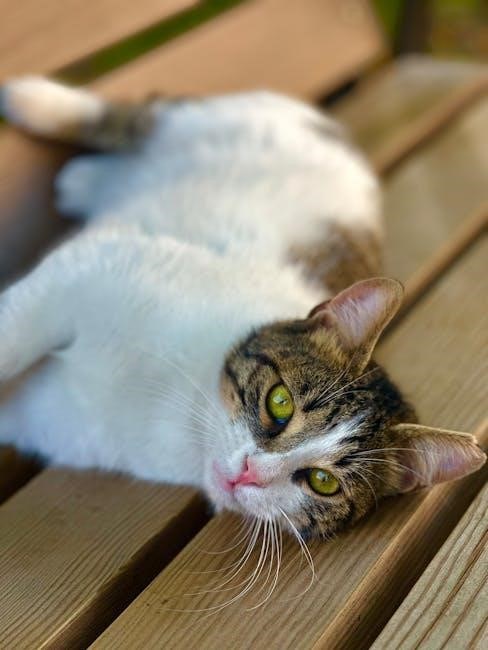Welcome to the Cat Quest Trophy Guide! This guide helps you unlock all achievements in this charming open-world RPG. Discover tips to explore, battle, and complete every quest for 100% completion. Enjoy your journey to become the ultimate Cat Quest master!

Overview of Cat Quest and Its Trophy System
Cat Quest is a charming open-world RPG where you embark on a thrilling adventure with your feline companion. The game features a straightforward trophy system, with 23 trophies in total: 7 bronze, 7 silver, 8 gold, and 1 platinum. These achievements are designed to guide you through the game’s core experiences, such as completing side quests, clearing dungeons, reaching level 99, and defeating dragons. The trophies are relatively easy to unlock, with an estimated completion time of 10-15 hours; This system encourages exploration, combat, and completionism, making it accessible for both casual players and trophy hunters. By earning these trophies, you’ll progress through the story and unlock the ultimate platinum trophy, marking your mastery of the game.
Importance of Trophies in Cat Quest
Trophies in Cat Quest play a vital role in enhancing your gaming experience. They serve as milestones, rewarding your progress and encouraging completion of various in-game activities. Earning trophies not only provides a sense of achievement but also unlocks the prestigious platinum trophy, symbolizing 100% completion. These achievements guide you through the game’s core mechanics, such as exploring the map, completing side quests, and mastering dungeons. Trophies also add replay value, motivating players to fully engage with the game’s content. By pursuing these awards, you’ll gain a deeper understanding of the game’s world and mechanics, making your journey even more rewarding and enjoyable. The trophy system is designed to be accessible, ensuring both casual and dedicated players can enjoy the satisfaction of earning each achievement. This structured progression keeps players engaged and invested in their adventure.
Structure of the Trophy Guide

This guide is organized to help you efficiently unlock all trophies in Cat Quest. It is divided into sections, starting with an introduction, followed by a detailed trophy list categorized by bronze, silver, gold, and platinum. Each trophy type is explained with specific requirements and tips. The guide then provides strategies for unlocking trophies through completing side quests, clearing dungeons, leveling up, and defeating dragons. Specific trophy guides offer in-depth instructions for challenging achievements like “Super Catventurer” and “Dragon Legend.” General tips and community resources are included to aid your journey. The guide concludes with final advice for 100% completion, emphasizing persistence and enjoyment. This structured approach ensures you can track your progress and achieve the coveted platinum trophy with ease and confidence.
Cat Quest Trophy List
Cat Quest features 23 trophies: 7 bronze, 7 silver, 8 gold, and 1 platinum. Trophies range from story-related achievements to completing side quests, clearing dungeons, and defeating dragons, offering a variety of challenges for players to conquer and enjoy.
Bronze Trophies
In Cat Quest, there are 7 bronze trophies, each offering a fun and accessible challenge. These achievements are designed to introduce players to the game’s mechanics and world. Examples include completing early side quests, such as “Helper of Cats” for finishing 6 quests, and “Dungeon Scrounger” for clearing 25 dungeons. Bronze trophies also reward players for reaching milestones like leveling up to 10 or exploring specific areas. These achievements are straightforward and serve as a foundation for progressing toward higher-tier trophies. Earning all bronze trophies lays the groundwork for unlocking more challenging accomplishments, making them a great starting point for new players. Use this guide to efficiently track and unlock each bronze trophy, ensuring a smooth journey through the game’s world and story.

Silver Trophies
Silver trophies in Cat Quest offer a moderate challenge, rewarding players for significant progress and specific achievements. There are 7 silver trophies, such as “Servant of Cats” for completing 30 side quests and “Dungeon Enthusiast” for clearing 50 dungeons. These trophies encourage players to delve deeper into the game’s world, completing more demanding tasks and reaching higher milestones, like leveling up to 50. Earning silver trophies requires dedication and a thorough exploration of the game’s content. They serve as a stepping stone toward the more elusive gold and platinum trophies, ensuring players are well-prepared for the ultimate challenges ahead. This guide provides tips to efficiently unlock each silver trophy, helping you progress smoothly through the game’s rewarding achievement system.
Gold Trophies
Gold trophies in Cat Quest represent the pinnacle of achievement, requiring exceptional dedication and skill. With 8 gold trophies available, players must accomplish extraordinary feats, such as reaching level 99 or clearing all 52 dungeons. These trophies are reserved for those who master the game’s mechanics, thoroughly explore every location, and complete the most challenging tasks. Notably, the “Super Catventurer” trophy demands reaching the maximum level, showcasing a player’s commitment to character development. Gold trophies are a testament to a player’s expertise and perseverance, offering a sense of pride and accomplishment upon unlocking. This guide provides detailed strategies to help you efficiently earn each gold trophy, ensuring your journey to 100% completion is both rewarding and enjoyable.
Platinum Trophy
The Platinum Trophy is the ultimate achievement in Cat Quest, representing 100% completion of the game. To unlock it, you must earn all other trophies, including completing every side quest, clearing all dungeons, reaching level 99, and defeating all dragons. This trophy is a testament to your dedication and mastery of the game. It is automatically awarded once all other achievements are unlocked. Earning the Platinum Trophy is a rewarding experience, as it signifies your completion of everything Cat Quest has to offer. This guide provides a comprehensive walkthrough to help you achieve this prestigious award, ensuring no step is missed on your journey to becoming a true Cat Quest legend. Celebrate your hard work with this shiny, well-deserved Platinum Trophy!

How to Unlock Trophies in Cat Quest
To unlock trophies in Cat Quest, focus on completing side quests, clearing dungeons, and reaching level 99. Defeating dragons and optimizing your equipment also plays a crucial role in achieving these milestones efficiently.
Completing Side Quests
Completing side quests is essential for trophy progression in Cat Quest. There are 62 side quests to finish, each offering unique rewards and contributing to the Saviour of Cats trophy. Start by visiting quest boards in towns and villages to accept missions. Some quests are straightforward, like fetching items, while others involve defeating enemies or solving puzzles. Completing six side quests earns you the Helper of Cats trophy, with more rewards as you progress. Certain quests may require significant gold, so manage your funds wisely. Exploring thoroughly ensures you don’t miss any hidden quests. Prioritize completing these early to strengthen your character and unlock higher-level content. Remember, side quests provide valuable experience and items crucial for tackling tougher challenges later in the game. Stay organized and enjoy the diverse adventures they offer!
Clearing Dungeons
Clearing dungeons is a critical part of earning trophies in Cat Quest. The game features 52 dungeons to explore, each filled with enemies, treasure, and challenges. To unlock the Dungeon Master trophy, you must clear all of them. Start by exploring the map thoroughly to discover hidden dungeons, as some are easy to miss. Equip your character with strong gear and ensure they are sufficiently leveled to handle tougher enemies. Clearing dungeons not only rewards valuable items and experience but also progresses you toward the platinum trophy. Be patient, as some dungeons require specific strategies or items to complete. Regularly revisiting areas and solving puzzles will help you conquer every dungeon and achieve this impressive milestone in your trophy journey.
Reaching Level 99
Reaching level 99 in Cat Quest is essential for unlocking the Super Catventurer trophy, a rare achievement that showcases your dedication. To level up efficiently, focus on completing side quests, clearing dungeons, and exploring the map thoroughly. Defeating enemies and collecting experience points is the primary way to gain levels. Equip your character with the best available gear to maximize damage output and survive tougher challenges. Utilize experience-boosting items if available to speed up the process. As you progress, leveling becomes more challenging, so consistent grinding in high-level areas is necessary. Reaching level 99 is a significant milestone that brings you closer to the platinum trophy, so stay committed and enjoy the journey to becoming the ultimate feline hero.
Defeating Dragons
Defeating dragons in Cat Quest is a challenging but rewarding task required for the Dragon Legend trophy. To succeed, locate each dragon’s lair by thoroughly exploring the map. Equip your cat with the best available weapons and armor, and consider upgrading or enchanting gear for enhanced performance. Stock up on potions and stat-boosting items to aid in battle. Ensure your character is at a high level by completing side quests and clearing dungeons to gain experience; Study each dragon’s unique attack patterns and weaknesses, possibly exploiting elemental vulnerabilities with appropriate weapons. Adapt your combat style, focusing on melee or ranged attacks as needed, and adjust your strategy based on the dragon’s moves. Persistence is crucial—each attempt provides valuable insights, helping refine your tactics. Stay patient and determined to conquer these formidable foes and claim the Dragon Legend trophy.
Specific Trophy Guides
Discover detailed strategies for earning the Super Catventurer, Saviour of Cats, Dungeon Master, and Dragon Legend trophies, each offering unique challenges and rewards in Cat Quest.
Super Catventurer Trophy
To unlock the Super Catventurer Trophy, you must reach level 99, the highest level in Cat Quest. This trophy is a significant milestone requiring consistent effort and effective leveling strategies. Focus on completing side quests, clearing dungeons, and defeating enemies to gain experience points. Equip strong gear and utilize abilities wisely to maximize XP gain. Explore the map thoroughly to ensure no quests or enemies are missed. Grinding in later stages can be efficient, especially in high-level dungeons. Stay persistent, as the journey to level 99 is rewarding and essential for 100% completion. This trophy showcases your dedication to mastering the game and becoming the ultimate feline adventurer.
Saviour of Cats Trophy
Earning the Saviour of Cats Trophy requires completing all 62 side quests in Cat Quest. This achievement highlights your commitment to helping every feline in need. Side quests are scattered across the map, often found on quest boards in towns or by interacting with NPCs. Each quest provides valuable rewards and contributes to your journey. To unlock this trophy, ensure you explore every nook and cranny, speak to all villagers, and fulfill their requests. Some quests may be challenging, but persistence and proper equipment will see you through. Completing all side quests not only grants this trophy but also enriches your gameplay experience, making your adventure even more satisfying and comprehensive.
Dungeon Master Trophy
The Dungeon Master Trophy is awarded for clearing all 52 dungeons in Cat Quest. Each dungeon offers unique challenges, enemies, and treasures, making this achievement both rewarding and demanding. To succeed, ensure your cat is well-equipped with upgraded gear and abilities. Strategize by exploring each dungeon thoroughly, defeating all enemies, and collecting hidden items. Completing dungeons also contributes to leveling up and unlocking other trophies. Patience and skill are key to mastering every dungeon, as some may require multiple attempts. This trophy is a testament to your dedication and skill in overcoming the game’s toughest challenges, making it a prized achievement for any player aiming for 100% completion.
Dragon Legend Trophy
The Dragon Legend Trophy is one of the most prestigious achievements in Cat Quest, requiring players to defeat all the powerful dragons scattered across the world. Each dragon has unique abilities and patterns, demanding strategic combat and well-prepared equipment. To earn this trophy, ensure your cat is at a high level with the best gear and abilities. Utilize potions and special attacks wisely to overcome these formidable foes. Defeating dragons not only grants this trophy but also contributes to overall game completion and other achievements. This challenge tests your mastery of the game’s combat system and rewards your perseverance with a rare and coveted trophy, symbolizing your journey as a true legend in the world of cats.

General Tips for Trophy Hunting
Maximize efficiency by focusing on leveling up, optimizing gear, and thoroughly exploring the map. Completing all quests and side quests ensures progress toward trophy milestones and 100% completion.
Leveling Up Efficiently
Efficient leveling in Cat Quest requires strategic planning. Focus on completing main story quests and side quests, as they provide substantial experience points. Exploring dungeons and defeating enemies also contributes to rapid level gains. Prioritize upgrading your equipment regularly to enhance your combat effectiveness, allowing you to tackle tougher challenges and acquire more XP. Utilize potions and buffs wisely to maximize your efficiency in battles. Additionally, revisiting previously cleared areas with stronger gear can yield extra experience. Consistency is key; allocate time daily to maintain steady progress. By following these tips, you’ll reach level 99 and earn the Super Catventurer trophy in no time.
Optimizing Equipment
Optimizing your equipment in Cat Quest is crucial for success. Regularly upgrade your weapons, armor, and accessories to ensure maximum stats. Equip items that complement your playstyle, whether focusing on strength, agility, or magic. Explore dungeons and chests to find rare and powerful gear. Enchant your equipment using resources found throughout the game to boost their effectiveness. Additionally, complete side quests and defeat bosses to acquire unique items. Always check the stats of each piece to ensure you’re using the best available gear. Properly optimizing your equipment will make battles easier and help you progress smoothly through the game. This strategy is essential for achieving the Armeowry and Furshionista trophies.
Exploring the Map
Exploring the map thoroughly is essential for trophy hunting in Cat Quest. Discover hidden dungeons, secret quests, and valuable treasure chests by venturing off the beaten path. Use your mini-map to spot quest markers and points of interest. Regularly check every nook and cranny, as some areas contain exclusive rewards. Boats are crucial for accessing islands, where unique items and quests await. Exploring also helps uncover all 52 dungeons, a requirement for the Dungeon Master trophy. Interact with NPCs to uncover hints about hidden locations. Keep an eye out for glowing chests, which often contain powerful gear. Systematic exploration ensures you don’t miss any side quests or hidden content, making it easier to achieve 100% completion and unlock trophies like Saviour of Cats.

Completing All Quests

Completing all quests in Cat Quest is vital for trophy hunting. Side quests and main story quests provide essential experience, gold, and items. There are 62 side quests to complete, with some appearing on quest boards in towns. Regularly check these boards to ensure you don’t miss any. Some quests, like Kitmas-themed ones, are time-sensitive or seasonal. Completing all side quests unlocks the Saviour of Cats trophy, a key step toward the platinum. Focus on finishing every quest promptly to avoid missing rewards and ensure progress. Quests also help level up your character and equip better gear, making future challenges easier. Prioritize quest completion to fully experience the game and efficiently work toward 100% completion.

Community Resources
Explore PSNProfiles for detailed trophy guides, join online forums like Reddit for tips, and watch YouTube tutorials for visual walkthroughs to aid your trophy journey in Cat Quest.
PSNProfiles Guide
PSNProfiles is an excellent resource for trophy hunters, offering detailed guides and trophy lists for Cat Quest. The platform provides comprehensive roadmaps, user-created guides, and tips to help you achieve 100% completion. Many users share their strategies for unlocking specific trophies, such as Super Catventurer and Dragon Legend. You can also find lists of all 23 trophies, including their types, requirements, and completion percentages. Additionally, PSNProfiles hosts discussions where players can ask questions and share their experiences. This community-driven approach ensures you have access to diverse perspectives and solutions for every trophy. Whether you’re stuck on a particular achievement or need a step-by-step walkthrough, PSNProfiles is a valuable tool to enhance your trophy hunting journey in Cat Quest.
Online Forums and Discussions
Online forums and discussions are vibrant hubs for Cat Quest players seeking trophy help. Communities on platforms like Reddit and Steam offer threads dedicated to trophy hunting, where users share tips and strategies. Many players discuss their experiences, providing insights into unlocking challenging trophies like Dragon Legend and Super Catventurer. These forums are ideal for troubleshooting specific achievements or finding alternative methods to complete tasks. Additionally, community members often post detailed guides and checklists for efficiently completing side quests and clearing dungeons. Engaging with these discussions can help you overcome obstacles and learn from others’ successes and failures, making your trophy journey smoother and more enjoyable in Cat Quest.

Video Guides and Tutorials
Video guides and tutorials are excellent resources for visual learners aiming to unlock all trophies in Cat Quest. Platforms like YouTube host numerous gameplay walkthroughs, focusing on specific trophy requirements such as defeating dragons or completing side quests. These videos provide step-by-step instructions, showcasing optimal routes for leveling up and strategies for conquering challenging dungeons. Many creators also highlight efficient methods for earning rare trophies like Super Catventurer and Dragon Legend. Additionally, some tutorials cover hidden secrets and shortcuts, ensuring players don’t miss out on any achievements. Whether you’re stuck on a particular quest or seeking general tips, these video guides offer practical insights to enhance your trophy-hunting experience in Cat Quest.
Congratulations on completing the Cat Quest Trophy Guide! With persistence and dedication, you’ve unlocked every achievement. Remember to enjoy the journey and celebrate your gaming triumphs!
Final Tips for 100% Completion
To achieve 100% completion in Cat Quest, focus on exploring every corner of the map, completing all side quests, and clearing every dungeon. Optimize your equipment regularly to ensure you’re prepared for challenging battles. Leveling up efficiently is key, so prioritize experience-rich areas and enemies. Don’t hesitate to revisit earlier zones with stronger gear to tackle tough encounters. Defeating all dragons is a must for the Dragon Legend Trophy, so strategize and grind if necessary. Lastly, utilize community resources like PSNProfiles guides and video tutorials for tricky achievements. Stay persistent, and remember to enjoy the journey—every trophy is a step closer to mastering this charming RPG adventure!
Importance of Persistence
Persistence is vital when aiming to unlock all trophies in Cat Quest. Some achievements, like reaching level 99 or defeating all dragons, require significant time and effort. Stay committed to your goals, even when progress feels slow. Regularly revisit challenging areas and practice strategies to overcome obstacles. Utilize the game’s mechanics, such as equipment upgrades and leveling, to strengthen your character. Don’t get discouraged by setbacks—each attempt brings you closer to success. Remember, the journey to 100% completion is rewarding, and persistence will ultimately lead to achieving the elusive Platinum Trophy. Keep pushing forward, and celebrate every milestone along the way!
Enjoying the Journey
While chasing trophies in Cat Quest, remember to embrace the game’s charm and enjoy the journey. The open-world design and whimsical humor are key parts of its appeal. Take time to explore hidden caves, interact with quirky NPCs, and uncover secret chests. Don’t rush—let the game’s lighthearted nature shine through; Completing side quests and dungeons is not just about trophies but also about immersing yourself in the world. Laugh at the puns, admire the vibrant visuals, and savor the satisfaction of progress. Trophy hunting is more enjoyable when balanced with fun. So, take breaks, experiment with builds, and relish the adventure. Enjoying the journey makes the ultimate reward—the Platinum Trophy—even sweeter!






























